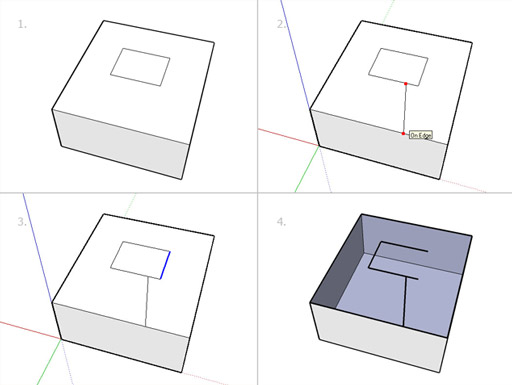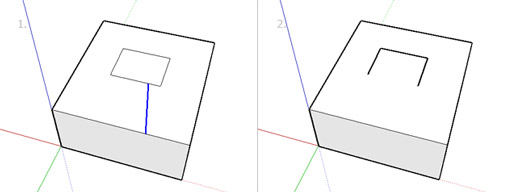[Plugin] Face Flattener 0.19
-
nice tool. I am definittely in danger of flattening every model I can lay my hands on (my colleagues won't like that
 ).
).I am looking forward to the "auto-cleanup" version.
cheers,
Jakob
-
@rv1974 said:
@Rayochoa:
This is a PLUG-IN. If you don't need it simply don't plug it.
IMHO it has a good potential. And if this tool will help me to save a couple of hours per year so why not?I didin't say i didn't like it i said that all these plugins are taking sketchup very far. But hey i like this better, rather than learning everything at the same time little by little is way better
-
-
 Thanks a lot
Thanks a lotWhat a waste of time I got, trying to understand why theses blood... lines didn't made a surface.friendly
 MALAISE
MALAISE
( sorry for my approximative english ) -
Dear Ray,
I tried out your script on the following simple model.
Draw a rectangle, say 100 mm by 100 mm, and then pull it up 10 mm into a 3D shape.
Use the move tool to pull up one corner on the top face by 0.1 mm.
Draw a few lines on the sides to divide areas into two, and perhaps a few random, un-terminated lines on various surfaces.
Select all and run your script.When I do this I lose the top face. Interestingly enough this also happens when I run the script cleanup_model.rb (by John H. Aughey). The script deletecoplanaredges.rb (by Jack Dolabany)removes all redundant co-planar lines, but leaves the top face with its centre fold untouched.
I imagine that this is not what you had in mind.
Kind regards,
Bob -
thanks, will be very useful
-
Hi Ray and Bob,
This is something I've noticed while working on my flattening script, and I still haven't figured out why it happens. The simplest way of reproducing this is to draw a box, add a rectangle to the top surface and connect it with a line to the outer edge loop. When erasing one of the edges of the rectangle that was added, both faces disappear.

However, if you were to erase the edge that connects both edge loops first, then you can erase the edges of the inside rectangle just fine. It apparently has to do with the order in which you erase coplanar edges. Delete edges in the following order: edges connected to 0 faces go first, then edges connected to 1 face, and finally edges connected to 2 faces.

See ya,
Zach -
Dear Zach,
The script deletecoplanaredges.rb failed your example too, so some recoding is needed to get a more reliable cleanup script.
Regards,
Bob -
@cerevellum said:
Hi Ray and Bob,
This is something I've noticed while working on my flattening script, and I still haven't figured out why it happens. The simplest way of reproducing this is to draw a box, add a rectangle to the top surface and connect it with a line to the outer edge loop. When erasing one of the edges of the rectangle that was added, both faces disappear...
Ha! Beautiful! I love these "glitch hunts". And you cannot even heal the face by redrawing an edge of it until you get rid of the leftover geometry in the middle!

-
Dear Gaieus,
Perhaps some of our script writers could come up with a more reliable clean-up script.
I note from Zach's example that the line joining the inner and outer loops is bounded by the same area, while the lines forming the inner and outer loops are bounded by different areas. What makes an area/surface unique, and could this be used to decide on the order of line removal? At least deletecoplaredges.rb leaves the centre fold line in an non-coplanar surface alone, and so perhaps this would be the script to start with. A nice icon would not go amiss, say an image of a few random, crossed lines.
Kind regards,
Bob -
Bob, Zach,
I have a script that creates a menu item "Remove unused edges" in the Edit menu (for the life I cannot locate the script anywhere to see the file name of it). Using the script it also deletes the top surface (so the order it deletes the lines must be wrong as well).
I have noticed a couple of times that using it leads me to lose a coupleof faces (especially after complex, curved intersections).
-
Dear Gaieus,
It is cleanup_model.rb.
Regards,
Bob -
Ah, thanks a bunch, Bob! I have always wondered and couldn't figure out (I keep a fairly nice mess in my Plugins folder).
-
You know what i don in order to get a 2d model is get the scale tool and type in .002 and then do that again by putting a line next to it and resizing again. then i just erase the lines i want after intersecting everything
-
 Perfect solution: export-import 2D hidd.line mode dwg.
Perfect solution: export-import 2D hidd.line mode dwg.
Not sure it canbe implemented in .rb though -
RE: Face flattener - I'll give it a shot... thanks for sharing!
Ray, and others, when wanting to export a flat model from SU to CAD format - don't forget the Automated 2D Output ruby! Then you can just re-import the .dwg file back into SU, and it will be flat.
-
-
hehe,hello.
-
@cerevellum said:
Hi Ray and Bob,
This is something I've noticed while working on my flattening script, and I still haven't figured out why it happens. The simplest way of reproducing this is to draw a box, add a rectangle to the top surface and connect it with a line to the outer edge loop. When erasing one of the edges of the rectangle that was added, both faces disappear.
What you can try to possibly avoid this problem is to calculate all coplanar segments, not delete them, but instead put them in a list (or in the selection). Then, just delete the entities in the list (or in the selection):
model.entities.erase_entities list_edges #or model.entities.erase_entities model.selectionIt seems to work fine on your example, and on some more complex configurations, but I did not try in the general case.
Note: manually in Sketchup, what I would use is to select all coplanar segments, put them in a group and then just delete the group. It leaves all faces intact. Unfortunately, there is no method in Ruby to make a group or a component out of existing elements!
-
Advertisement







